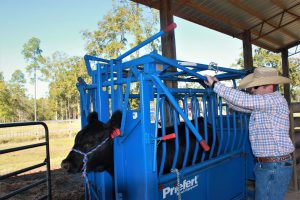Ensuring that we are able to properly manage and handle our animals periodically throughout the year is important to ensure we are keeping a close eye on their performance. We take this time to evaluate the condition of the animal, general health, administer vaccinations, castrate and artificial inseminate among other important management practices. Taking care to efficiently move these animals through a working facility can reduce stress on the animals, and on you! Low-stress cattle handling has been shown to increase productivity and profitability in cattle productions.
We should take a look at least once a year to look at the general condition of our equipment, facilities, supplies and make changes when and where they are most needed. Taking time in “down time” parts of the year is good practice to ensure the next time your facility is needed you have no issues. Some good things to start with is examination of the overall condition of the barn, shed or cover over the equipment. Does the facility have proper support?  Does the electrical system need any repair? Can you add more lighting to allow for better visibility? Do you need to expand? Most of the questions require a financial solution, so consideration of where your operation is and may be going will need to be taken into account. New lighting or expanded working area can help improve safety and work space use.
Does the electrical system need any repair? Can you add more lighting to allow for better visibility? Do you need to expand? Most of the questions require a financial solution, so consideration of where your operation is and may be going will need to be taken into account. New lighting or expanded working area can help improve safety and work space use.
Examine the alleys, holding pens and gates that surround your working facility. Moving parts are probably the most important component to inspect during this time. Not only do you need gates to open and close, but they need to do so to ensure safety to you and your animals. Hinges for gates should be secured to a metal or wooden post with no breaks in the welds that hold them in place. It’s also good for gates to be suspended a few inches off of the ground so they can freely swing in the direction intended. If your working pens are primarily built out of wood, it’s good practice to ensure that boards are not rotten, bowed, or loose. Check nails or screws to ensure they are secured flush with the board and are not exposed. Shoulder or hip lacerations can occur which brings on infection and the risk of tetanus.
If your pens are composed of metal pipe, take time to check welded joints and that the integrity of the pipe is still optimal. Normal wear and tear occurs in all working facilities but broken or exposed metal from piping can be a cut hazard and can also lead to unnecessary infection and added treatment costs. Most commercial metal gates and panels on the market are built to be weather resistant but in time extreme rust can lead to a decrease in the strength of the product. Again, check that hinges are secure and tight but allow for gates to swing freely without dragging the ground.
Next take extra time to inspect the sweep tub (if applicable), alley and chute. These are probably the most crucial parts of your working facility as we require them to hold and secure 1,000 to 1,500 lb animals for 10 minutes or more. These pieces of equipment should be structurally sound, well maintained, and functional for your purposes. Just as with inspecting the pens and gates, your chute should be inspected for any malfunctions, exposed metal or wood, and all moving joints should be kept clean and lubricated periodically. Test out your equipment if it has been a while since last use and do so several days prior to animal use to allow for repairs or maintenance. You also want to keep your work area near the chute clear of trip hazards and have solid, comfortable footing especially for all-day situations. Grooved rubber mats on either side of the chute can provide good traction and comfort for you and your working crew. Consider some type of high traction footing for your alleys and chute as well. As more cattle are worked through the facility, an increase of manure and urine can make it difficult for cattle to move through without the chance of slipping. Grooved concrete, rubber mats work well and the recycled rubber tire mats that are gaining popularity have become more common.
Lastly, make sure you have all off the necessary items near the working facilities that will maintain a safe working environment. This can include fire extinguishers, first aid-kits (for workers and cattle), ropes, chains, halters, gloves, and tools. Everything that you need should be within arm’s reach or a few steps away. Try not to clutter the workspace but be organized and ready for different situations. No two facilities are the same so take time to visit other operations and share ideas on what works well and what needs improvement. It’s never too early to start improving your operation. Stay safe!
 0
0
